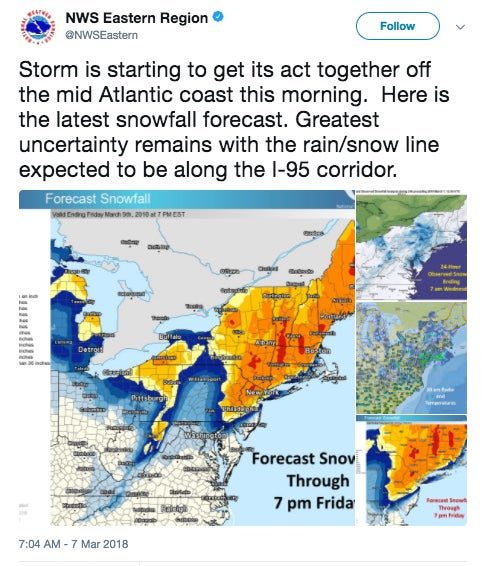
Just days after Winter Storm Riley slammed the East Coast, another nor’easter is on its way. Winter Storm Quinn is expected to deliver heavy snowfall from Philadelphia to Boston Wednesday.
Scientists say that climate change is fueling stronger nor’easters by warming the seas. Nor’easters form when balmy ocean breezes collide with cold air from over the continent. The larger the difference in temperature, the more powerful the storm.
New Jersey and Pennsylvania declared states of emergency ahead of the storm. Several Northeast cities have closed schools, and airlines have cancelled more than 2,000 flights. The storm comes at an inauspicious time, as more than 100,000 homes and businesses in Pennsylvania, New Jersey, and New York are still without power following last week’s nor’easter.
Meteorologists say that the New York and Philadelphia metropolitan areas could see more than a foot of snow, though there is a wide range of uncertainty because depending on which path the storm takes, it could dump that precipitation as rain instead of snow. The boundary between the area that will see rain and the area that will see snow — what meteorologists call the rain-snow line — more or less runs along Interstate 95.

While Winter Storm Quinn won’t produce the same high-powered winds as Winter Storm Riley, the storm is expected to deliver winds up to 60 mph to New Jersey, Long Island, and New England. Experts say these areas should prepare for minor coastal flooding. More than a century of sea-level rise has made seaside cities and towns more vulnerable to floods.
Officials expect snow and wind will damage trees, and they are urging those in the path of the storm to stay indoors away from windows. They recommend preparing for widespread power outages by charging portable devices and checking flashlight batteries. On the bright side, many are reporting instances of “thundersnow”—you can read more about that rare and delightful phenomenon here.
If Quinn feels like it should be last big blizzard of the season, don’t get your hopes up. Another coastal storm is likely to strike next week.
Jeremy Deaton writes for Nexus Media, a syndicated newswire covering climate, energy, policy, art and culture. You can follow him @deaton_jeremy.









